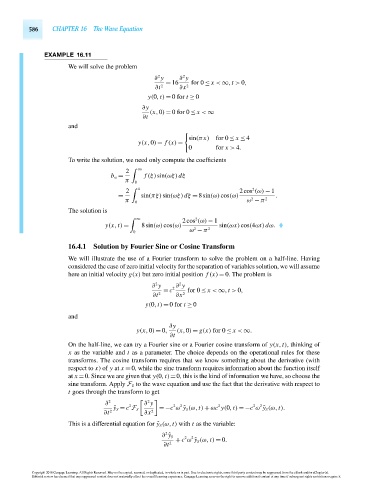Page 606 - Advanced_Engineering_Mathematics o'neil
P. 606
586 CHAPTER 16 The Wave Equation
EXAMPLE 16.11
We will solve the problem
2
2
∂ y ∂ y
= 16 for 0 ≤ x < ∞,t > 0,
∂t 2 ∂x 2
y(0,t) = 0for t ≥ 0
∂y
(x,0) = 0for0 ≤ x < ∞
∂t
and
sin(πx) for 0 ≤ x ≤ 4
y(x,0) = f (x) =
0 for x > 4.
To write the solution, we need only compute the coefficients
2 ∞
b ω = f (ξ)sin(ωξ)dξ
π 0
2
2 4 2cos (ω) − 1
= sin(πξ)sin(ωξ)dξ = 8sin(ω)cos(ω) .
π 0 ω − π 2
2
The solution is
∞ 2cos (ω) − 1
2
y(x,t) = 8sin(ω)cos(ω) sin(ωx)cos(4ωt)dω.
2
ω − π 2
0
16.4.1 Solution by Fourier Sine or Cosine Transform
We will illustrate the use of a Fourier transform to solve the problem on a half-line. Having
considered the case of zero initial velocity for the separation of variables solution, we will assume
here an initial velocity g(x) but zero initial position f (x) = 0. The problem is
2
2
∂ y ∂ y
= c 2 for 0 ≤ x < ∞,t > 0,
∂t 2 ∂x 2
y(0,t) = 0for t ≥ 0
and
∂y
y(x,0) = 0, (x,0) = g(x) for 0 ≤ x < ∞.
∂t
On the half-line, we can try a Fourier sine or a Fourier cosine transform of y(x,t), thinking of
x as the variable and t as a parameter. The choice depends on the operational rules for these
transforms. The cosine transform requires that we know something about the derivative (with
respect to x)of y at x = 0, while the sine transform requires information about the function itself
at x =0. Since we are given that y(0,t)=0, this is the kind of information we have, so choose the
sine transform. Apply F S to the wave equation and use the fact that the derivative with respect to
t goes through the transform to get
2
∂ 2 ∂ y
2 2 2 2 2 2
ˆ y S = c F S =−c ω ˆy S (ω,t) + ωc y(0,t) =−c ω ˆy S (ω,t).
∂t 2 ∂x 2
This is a differential equation for ˆy S (ω,t) with t as the variable:
2
∂ ˆy S 2 2
+ c ω ˆy S (ω,t) = 0.
∂t 2
Copyright 2010 Cengage Learning. All Rights Reserved. May not be copied, scanned, or duplicated, in whole or in part. Due to electronic rights, some third party content may be suppressed from the eBook and/or eChapter(s).
Editorial review has deemed that any suppressed content does not materially affect the overall learning experience. Cengage Learning reserves the right to remove additional content at any time if subsequent rights restrictions require it.
October 14, 2010 15:23 THM/NEIL Page-586 27410_16_ch16_p563-610

